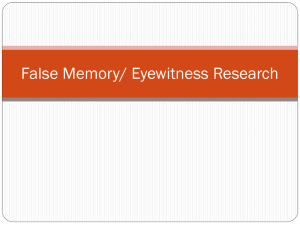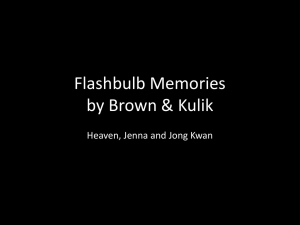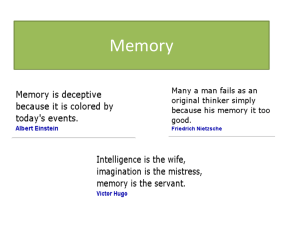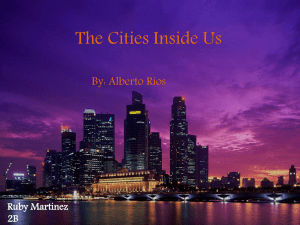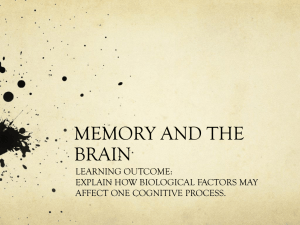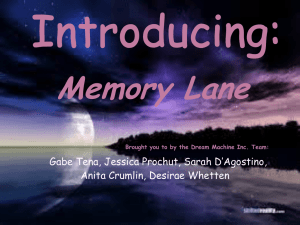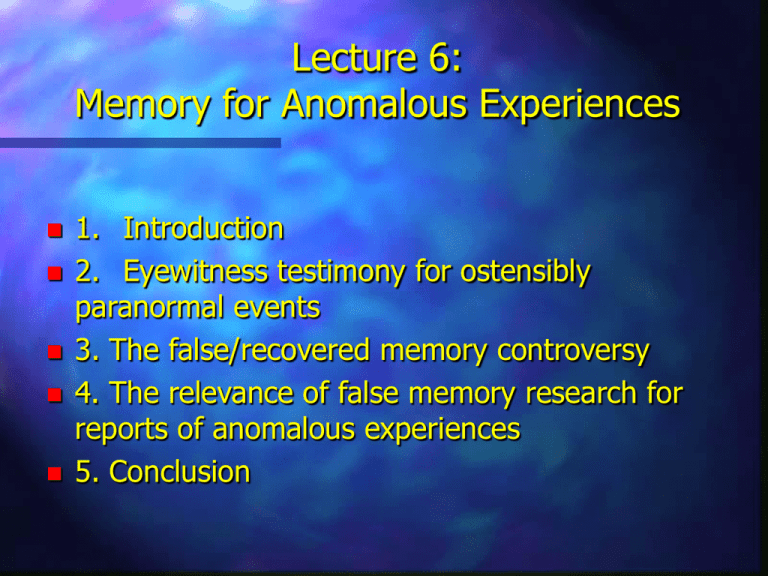
Lecture 6:
Memory for Anomalous Experiences
1. Introduction
2. Eyewitness testimony for ostensibly
paranormal events
3. The false/recovered memory controversy
4. The relevance of false memory research for
reports of anomalous experiences
5. Conclusion
David Hume (1748)
Of Miracles
No testimony is sufficient to establish a
miracle unless that testimony be of such
a kind that its falsehood would be more
miraculous than the fact which it
endeavours to establish.
Factors Affecting
Eyewitness Accuracy
Memory is less accurate for
– peripheral details
– stimuli presented briefly
– under imperfect viewing conditions
– stimuli presented when we are underaroused (e.g., drowsy) or over-aroused
(e.g., frightened)
How is the 4 represented?
Schema Theory (1)
(Cohen, 1989)
It can account for the fact that many of
our experiences are forgotten, or are
reconstructed in a way that is
incomplete, inaccurate, generalised, or
distorted. Schema theory emphasises
the role of prior knowledge and past
experience, claiming that what we
remember is influenced by that which
we already know.
Schema Theory (2)
(Cohen, 1989)
According to this theory, the knowledge
we have stored in memory is organised
as a set of schemas, or knowledge
structures, which represent the general
knowledge about objects, situations,
events, or actions that has been
acquired from past experience.
Leading Questions
(Loftus, 1979)
Estimates of speed of car affected by
“smashed into” vs “contacted”
“Did you see the broken headlight?” vs
“Did you see a broken headlight?”
Memory Conformity
(Gabbert, Memon & Allen, 2003)
Multiple similar accounts given greater
evidential weight but…
… witnesses may discuss event and
influence each other’s memory
Shown to be the case with staged crime
on video
Victorian Séances
Apports
Levitation of Objects
Materialisation
S John Davey, 1887 (1)
Davey had been converted to a belief in
spiritualistic phenomena by the slate-writing
demonstrations of the medium Henry Slade.
Subsequently Davey accidentally discovered
that Slade had employed trickery to produce
some of the phenomena. Davey practised
until he felt he could accomplish all of Slade's
feats by trickery and misdirection.
S John Davey, 1887 (2)
He then conducted his well-rehearsed
seance for several groups of sitters,
including many who had witnessed and
testified to the reality of spiritualistic
phenomena. Immediately after each
seance, Davey had the sitters write out
in detail all that they could remember
having happened during his seance.
S John Davey, 1887 (3)
The findings were striking and very
disturbing to believers. No one realized
that Davey was employing tricks. Sitters
consistently omitted crucial details,
added others, changed the order of
events, and otherwise supplied reports
that would make it impossible for any
reader to account for what was
described by normal means.
Other Fake Séance Studies (1)
Besterman (1932)
– sitters failed to report experimenter leaving
the room
– reported stationary objects moving
Other Fake Séance Studies (2)
Wiseman, Smith, & Wiseman (1995)
– 1 in 5 sitters reported that maracas had
been examined when they had not
– 27% of sitters reported at least one object
moving that had not
– 1 in 4 sitters reported that table had not
moved when it had
– 1 in 5 believers thought they had
witnessed paranormal phenomena (no
disbelievers did so)
Verbal Suggestion and PK
Metal Bending
Wiseman & Greening (2005) presented
participants with video clip of fake psychic
apparently bending key with PK (actually
using sleight of hand)
“Psychic” puts key on table and suggests it is
still bending (it isn’t)
Around 40% of witnesses report that key
continued to bend (but virtually no one did in
no-suggestion condition)
No differences in susceptibility between
believers and disbelievers
Memory Conformity
The phenomenon whereby the testimony of
one eyewitness directly influences the
testimony provided by a second eyewitness
Wilson & French (submitted) replicated
Wiseman & Greening’s (2005) “It’s still
bending”
But found believers more susceptible
Added memory conformity element, showing
social influence on eyewitness reports
Explanations of Verbal
Suggestion Effects
Direct effect on perception?
Effect on memory?
Both?
Neither? Demand characteristics?
Recall of “Pseudopsychic”
Demonstrations
Wiseman & Morris (1995)
– believers rated demonstrations as more
“paranormal”
– believers tended to be less accurate in
recalling “important” information
Jones & Russell (1980)
– accurate recall of “successful” and
“unsuccessful” ESP demonstrations by
disbelievers, but believers rated both
demonstrations as successful
The Indian Rope Trick
(Lamont & Wiseman, 2001)
– In the classic version of the Indian rope trick the
performer first causes a rope to rise into the air.
His boy assistant then clambers up the rope and
promptly disappears. Next, the performer climbs
the rope after the boy and also vanishes.
Moments later, the dismembered parts of the
boy’s body fall to the ground. The performer now
descends the rope and puts these parts into a
basket. Finally, the boy jumps from the basket,
fully restored to life.
Eyewitnesses to Hoax UFO
Simpson (1979-80) carried out hoax in
March 1970 at Cradle Hill, Warminster
Light on hill was stationary but reported
by UFO spotters to be above hill and
moving
Factors often associated with
“paranormal” events
poor viewing conditions (e.g., darkness or semidarkness)
altered states of consciousness (e.g., due to
–
–
–
–
tiredness
biological trauma
engaging in particular rituals
drug abuse
emotional arousal
Either
– ambiguous and unexpected nature of the event (in
spontaneous cases) or
– high level of expectation and will to believe on the other
(e.g., in a séance)
Sigmund Freud
The Seeds of Repression?
Repression
George Franklin, Sr., convicted of
murder on basis of “recovered”
memories of events 20 years earlier
Holmes (1990): “Warning. The concept
of repression has not been validated
with experimental research and its use
may be hazardous to the accurate
interpretation of clinical behavior”
Repression (cont.)
Celebrity cases on Oprah Winfrey Show, e.g.,
Roseanne Barr Arnold
Special issues of journals
Guidelines from national psychological and
psychiatric associations
The claim that repression of CSA is common,
causes problems in adulthood and can be
cured by therapy not supported by systematic
empirical observation (e.g., no outcome
studies)
Bloom (1994, p.469):
I believe that many of the voices of the
backlash are, if not perpetrators
themselves, then apologists for
perpetrators, whether knowingly or
unknowingly, and it is this defence of
the status quo and protection against
the revelation of this secret that arouse
such vituperative defence and counterattack.
Bowers & Farvolden (1996, p.362):
The grounds for this reaction are
straightforward: Child sexual abuse
occurs frequently and leaves lasting
psychological scars -- especially when
abuse victims are unable to remember
or speak of it (Summit, 1983). With
considerable pain and anguish, Freud's
patients (mostly women) revealed to
him the abuse they had suffered as
children, most often at the hands of
their fathers. For a while, he listened to
them.
Bowers & Farvolden continued:
However, because such reports were so
unpalatable and so unpopular, Freud
switched allegiances: Rather than speaking
the truth on behalf of his patient, he
courted the favor of his peers. He did so by
rejecting the patient's abuse memories as
an accurate reflection of historical events
and chose to regard them as fantasies
instead. To have discovered the Truth and
then abandoned it to curry favor with
professional colleagues is morally
reprehensible.
Freud’s Position
Freud’s initial claims of CSA were denied by
his patients
But they were based on his interpretation of
various signs, symptoms, dreams and
fantasies – not conscious memories
Freud then decides these “recovered”
memories were constructed by his patients –
not based on suggestions from him!
Childhood Sexual Abuse
and Repression
CSA is a serious problem
But how often is CSA experienced and then
forgotten?
Blume (1990) claims “most incest survivors
have limited recall about their abuse" and
"half of all incest survivors do not remember
that the abuse occurred"
But where are the data to support these
assertions?
Estimates of Repression
of CSA Memories
Loftus (1993) reports wide range, 18% to
59%
Survey questions open to different
interpretations, e.g., "During the period of
time between when the first forced sexual
experience happened and your 18th birthday
was there ever a time when you could not
remember the forced sexual experience?"
Loftus (1993, p.523):
The plaintiff, Bonnie, in her late 40s at the time
of the trial, accused her parents of physically,
sexually, and emotionally abusing her from
birth to approximately age 25. A sister, Patti, in
her mid-30s at the time of trial, said she was
abused from infancy to age 15. The allegations
involved torture by drugs, electric shock, rape,
sodomy, forced oral sex, and ritualistic killing of
babies born to or aborted by the daughters.
The events were first recalled when the
plaintiffs went into therapy in the late 1980s.
“Recovered” Memories
Reports of memories of abuse during
first years should be treated with
caution in light of childhood amnesia
Psychotherapists and clinical
psychologists often believe clients’
recovered memories on basis of
symptomatology (e.g., low self-esteem)
or “body memories”.
Bass & Davis (1988, p.22):
You may think you don't have memories, but
often as you begin to talk about what you do
remember, there emerges a constellation of
feelings, reactions and recollections that add up
to substantial information. To say, "I was
abused," you don't need the kind of recall that
would stand up in a court of law. Often the
knowledge that you were abused starts with a
tiny feeling, an intuition... Assume your feelings
are valid. So far, no one we've talked to
thought she might have been abused, and then
later discovered that she hadn't been. The
progression always goes the other way, from
suspicion to confirmation. If you think you were
abused and your life shows the symptoms,
then you were.
Bradshaw (1992, p. 49):
Do you have trouble knowing what you want? Are
you afraid to try new experiences? If someone gives
you a suggestion, do you feel you ought to follow it?
According to Bradshaw, if you answered even one of
these questions "yes," then you "can count on some
damage having been done to you ... between the 9th
and 18th months of your life".
Influence of Therapists
Encouraging patients to “make up a
story” as a way of recovering memories
Dream interpretation
Support groups
Hypnosis
Yapko (1994 p.163):
Survey data regarding hypnosis and suggestibility
indicate that while psychotherapists largely
view hypnosis favorably, they often do so on
the basis of misinformation. A significant
number of psychotherapists erroneously
believe, for example, that memories obtained
through hypnosis are more likely to be accurate
than those simply recalled, and that hypnosis
can be used to recover accurate memories
even from as far back as birth. Such
misinformed views can lead to misapplications
of hypnosis when attempting to actively
recover memories of presumably repressed
episodes of abuse, possibly resulting in the
recovery of suggested rather than actual
memories.
Clients’ Accounts
Typically no conscious memories of CSA
at start of therapy
Use of unvalidated techniques to
recover memories
Leading questions from therapists
Pynoos & Nader (1989, p.238):
One girl initially said that she was at the school
gate nearest the sniper when the shooting
began. In truth she was not only out of the line
of fire, she was half a block away. A boy who
had been away on vacation said that he had
been on his way to the school, had seen
someone lying on the ground, had heard the
shots, and then turned back. In actuality, a
police barricade prevented anyone from
approaching the block around the school.
“Flashbulb Memories”
(Brown & Kulik, 1977)
It was once believed that certain highly
emotional events could lead to
memories that were highly vivid and
accurate
Even flashbulb memories can often be
inaccurate (see, e.g., Neisser & Harsch,
1993, for a study of flashbulb memories
of the Challenger disaster)
“Lost in a Shopping Mall”
14-year-old boy asked to recall events
from childhood including one which
never happened
Repeated interviewing led to formation
of false memory
FMs for more dramatic events (e.g.,
childhood stays in hospital) produced in
subsequent research
Lindsay & Read (1995, p. 865):
[...] extreme forms of memory work in psychotherapy
combine virtually all of the factors that have been
shown to increase the likelihood of illusory memories
or beliefs (a) a trusted authority communicates a
rationale for the plausibility of hidden memories of
long-ago childhood trauma (that many clients have
hidden memories, that the client's psychological
symptoms, physical symptoms, and dreams evidence
them, and that doubt is a sign of "denial") and (b) a
trusted authority provides motivation for attempting
to recover such memories (that healing is contingent
on retrieving hidden memories)
Lindsay & Read (1995, p.865):
repeatedly exposed to
suggestive information from multiple sources
(c)
the
client
is
(anecdotes in popular books, other survivor's
stories, comments and interpretations offered
by the therapist, etc.), providing a "script" for
recovering memories as well as suggestions
about particular details; and (d) techniques
such as hypnosis and guided imagery enhance
imagery and lower response criterion such that
people are more willing to interpret thoughts,
feelings, and images as memories.
Experimental Techniques in
False Memory Research
DRM technique (Deese, 1959; Roediger &
McDermott,1995)
“Lost in a shopping mall” (e.g., Loftus &
Pickrell, 1995)
Hypnotic suggestion (e.g., Orne, 1979)
Imagination inflation (e.g., Loftus, 2001)
“Crashing memories” (e.g., Wilson & French,
2006)
Theoretical Approaches
to False Memories
Hyman & Kleinknecht’s (1998) explanation of
misinformation effects:
– presented information is judged with respect to
plausibility
– an event memory must be constructed on the
basis of schematic knowledge plus personal
experiences, suggestion, and current situational
demands
– the individual must commit a source monitoring
error in which the constructed memory is accepted
as reflecting the initial event rather than
misinformation presented following the event.
Role of Source Monitoring
The ability to accurately determine the
original source of information (Johnson,
Hashtroudi & Lindsay, 1993)
One specific aspect of particular
relevance is reality monitoring ability,
i.e., to distinguish between memories
based upon external events and those
generated by internal mental processes
Susceptibility to False
Memories
Correlates with:
– Fantasy proneness, e.g., Spanos, Burgess,
& Burgess, 1994
– Hypnotic suggestibility, e.g., Barnier &
McConkey, 1992
– Dissociativity, e.g., Hyman & Billings, 1998
– Absorption, e.g., Eisen & Carlson, 1998
– Vividness of visual imagery, e.g., Winograd,
Peluso, & Glover, 1998
Paranormal Belief and/or
Experience
Correlate with
– Fantasy proneness, e.g., Irwin, 1990, 1991
– Hypnotic suggestibility, e.g., Kumar &
Pekala, 2001
– Dissociativity, e.g., Wolfradt, 1997
– Absorption, e.g., Irwin, 1985
– Vividness of visual imagery, e.g., Diamond
& Taft, 1975
Reports of Anomalous Events
– FMs?
Until recently, attempts to demonstrate
a direct link between susceptibility to
FMs and tendency to report anomalous
experiences had met with limited
success (French, 2003)
Due to use of inappropriate FM
methodologies?
Plausibility and False
Memories
Mazzoni, Loftus, & Kirsch (2001) propose a 3stage model
For a false memory to develop:
– the event in question must be deemed to be
plausible
– the individual must have good reason to believe
that the event is likely to have happened to them
personally
– they must interpret their thoughts and fantasies
about the event as actual memories
False Memories for News
Coverage
Wilson & French (2006) gave 100 participants
a “News Coverage Questionnare”
Four items relate to actual news footage, one
relates to non-existent footage (i.e., CCTV
footage of first Bali bombing)
36% “remember” Bali footage
These individuals score higher on measures
of paranormal belief and experience
Effect has been replicated
Fantasy Proneness
Correlates with paranormal belief and reports
of OPEs (e.g., Irwin, 1990, 1991) and
hypnotic susceptibility (Wilson & Barber,
1983)
Very vivid imaginations, sometimes confuse
imagination with reality
Correlates with reports of childhood abuse –
a defence mechanism (Lynn & Rhue, 1988;
Rhue & Lynn, 1987)?
Dissociation
DSM-IV (1994): “A disruption in the usually
integrated functions of consciousness,
memory, identity, or perception of the
environment. The disturbance may be sudden
or gradual, transient or chronic.”
Develops as a defence mechanism?
Correlates with reports of childhood abuse
(e.g., Mulder et al., 1998)
Possible Explanations
Sceptics would argue that fantasy-prone
individuals imagine paranormal events and
them believe them to have really occurred.
Proponents of the paranormal argue that
“fantasy proneness may engender
paranormal belief, which in turn may be
conducive to parapsychological experience”
(Irwin, 1991, p. 321)
Maybe reports of both childhood abuse and
paranormal experiences are based upon false
memories? (But not supported by results of
French & Kerman, 1996)
Conclusions (1)
Research into the accuracy of
eyewitness testimony for OPEs strongly
suggests that such reports should be
treated with caution in light of:
– Basic unreliability of human memory
– Susceptibility to verbal suggestions
– Susceptibility to misinformation
Conclusions (2)
Recent studies support the idea that
believers in the paranormal may be
more susceptible to false memories,
even for non-paranormal events
Future research should be directed
– At confirming such findings with a wider
range of experimental techniques
– At further exploration of the link with
reports of childhood trauma
Acknowledgement
With thanks to Hilary Evans, proprietor of
the Mary Evans Picture Library, for
permission to use illustrations featured
in this presentation. These illustrations
must not be reproduced in any form
without permission from the Mary Evans
Picture Library.

